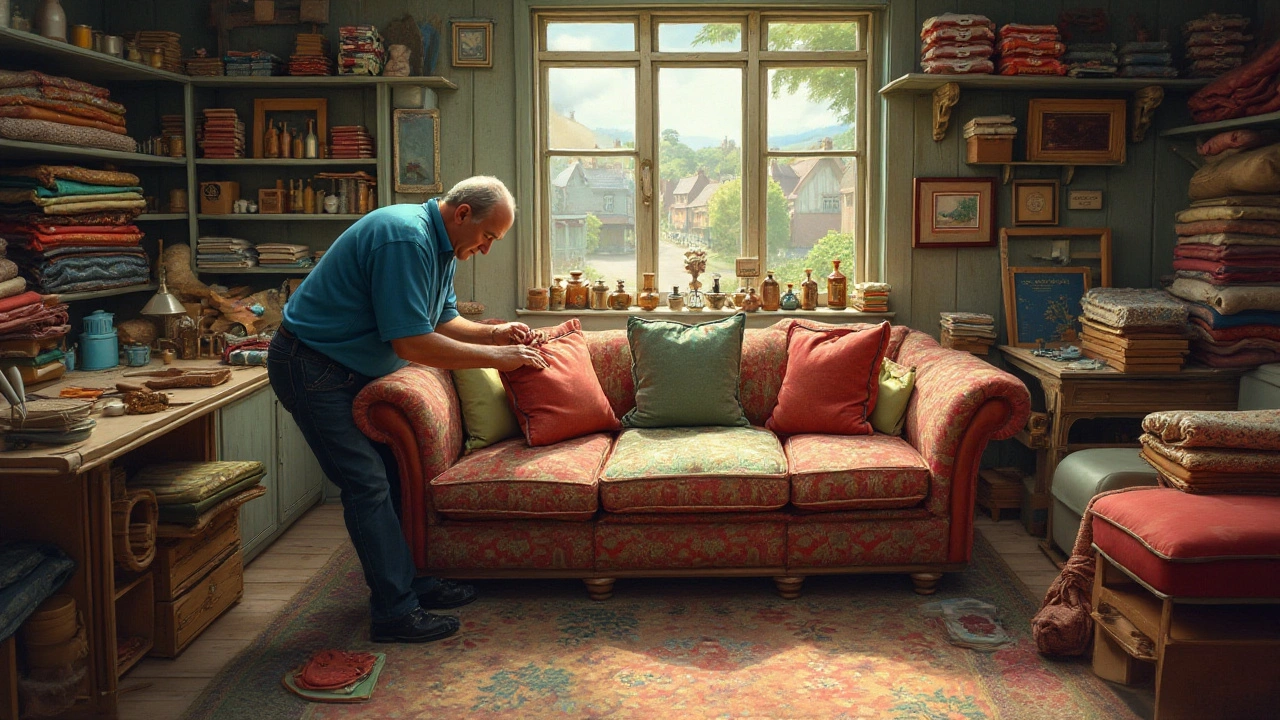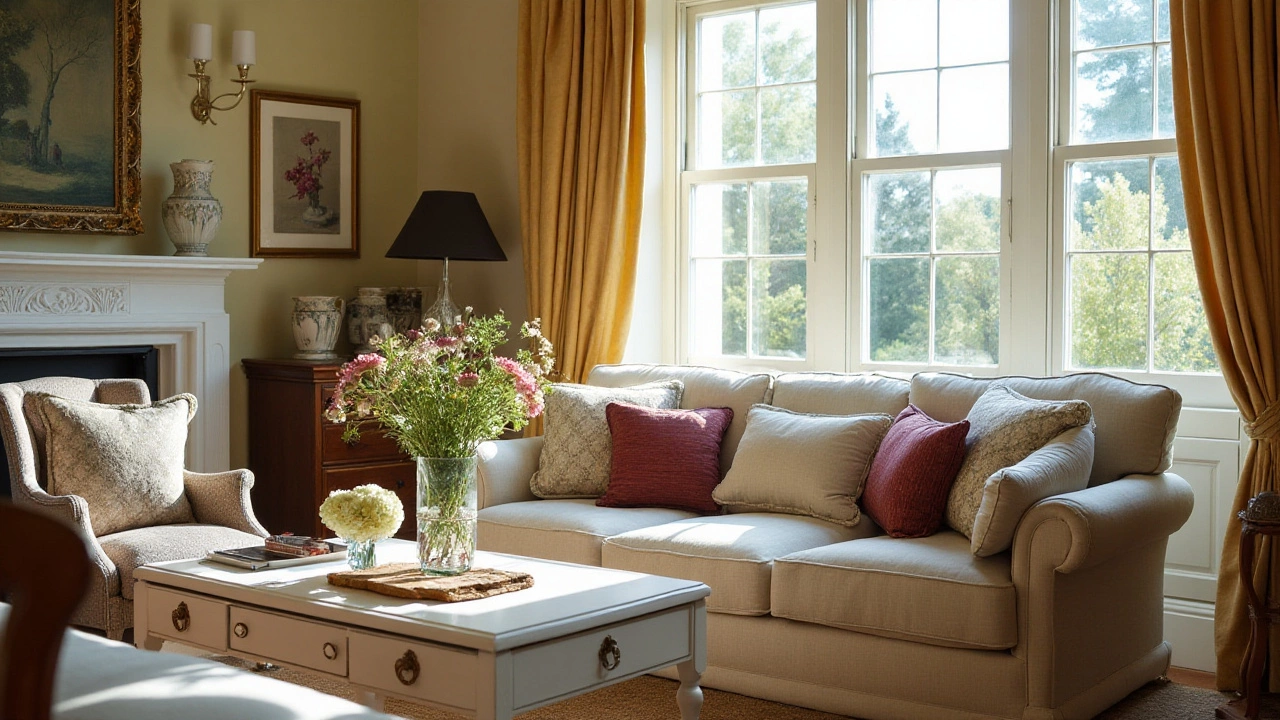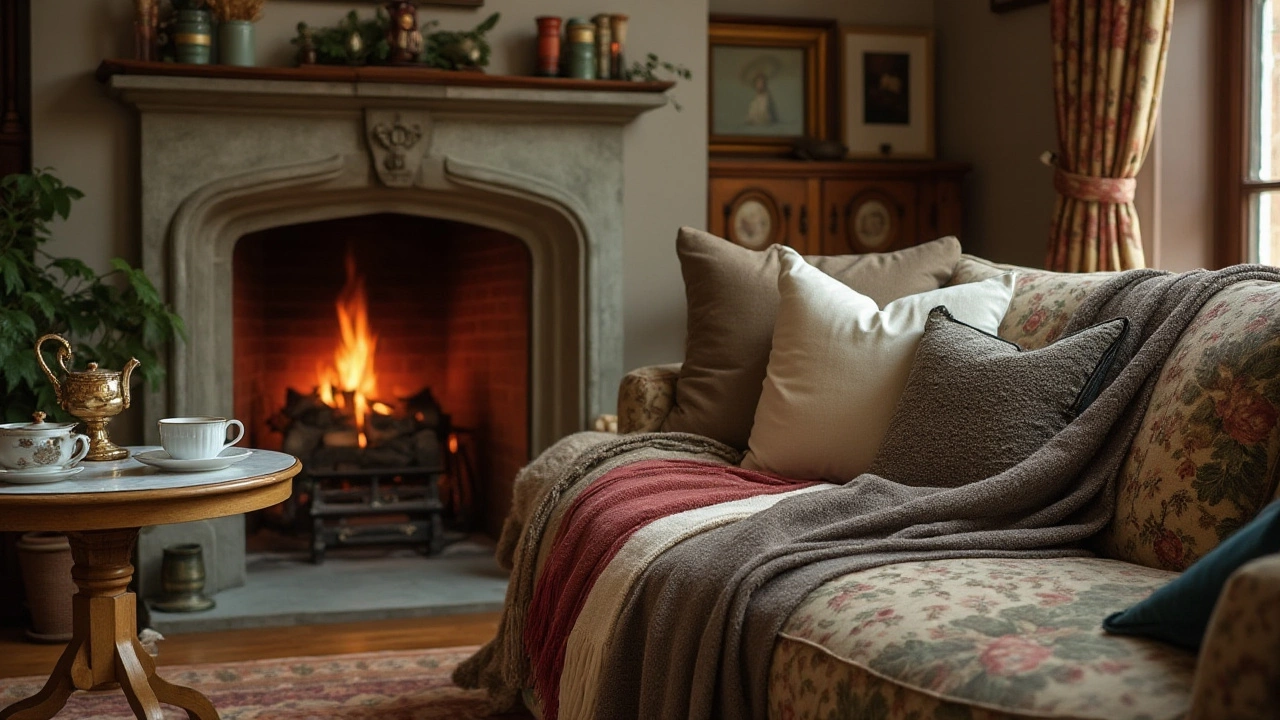Reupholstering your sofa cushions can transform an old piece of furniture into a fresh focal point in your home. Before you embark on this project, it's crucial to understand the costs involved. Not just about replacing fabric, it entails considering labor, quality of materials, and whether or not you'd like to take the DIY route.
From cotton to luxurious leather, the type of fabric you choose will significantly impact your budget. Professional services may add a hefty sum, but they guarantee a certain level of expertise and quality. On the flip side, choosing to do it yourself could save money, yet requires time and skill.
Deciding to reupholster is not merely a financial decision—it's a design one too. How you approach it could breathe new life into your home with some careful planning and a bit of creativity.
- Understanding Fabric Costs
- Labor and Professional Fees
- Additional Materials and Tools
- DIY Versus Professional Upholstery
- Tips for Choosing the Right Fabric
- Maintenance and Care for Upholstered Cushions
Understanding Fabric Costs
When it comes to reupholstering sofa cushions, the fabric you choose plays a pivotal role in both the aesthetic and the financial outcome of your project. The market offers a stunning variety of fabrics ranging in texture, durability, and price. To a large extent, your selection will depend on your lifestyle needs and personal taste. Is your home bustling with kids and pets, or is it a serene retreat? These considerations could tip the scales towards durable, stain-resistant options like microfiber or a plush, cozy feel with velvets or wools.
The cost of upholstery fabric varies widely, usually priced per yard. You can expect to spend anywhere from $30 to $200 per yard depending on the material. Basic cotton fabrics may sit at the lower end of the spectrum, offering affordability and a wide range of patterns and colors. Leather and high-end designer fabrics, on the other hand, could veer towards the pricier end, making a dramatic statement with their rich textures and luxurious feel. Considering that an average sofa cushion might require about two to three yards of fabric, even a small sofa project can see costs quickly add up.
Another layer of depth is added when you dive into the concept of material performance. Quality fabrics undergo rigorous testing to ensure longevity.
As interior designer Jane Smith suggests, 'Investing in good fabric is like buying peace of mind for furniture you love'.To make a sound investment, look for a balanced mix of quality and affordability, aiming for something that can withstand everyday use. High-density materials might fend better against wear and tear, which in turn could elongate the lifespan of your decorated cushions.
Affordability also ties into how efficiently you use your chosen fabrics. When purchasing, consider ordering a little extra to account for potential mistakes or future repairs. It's a skill to perfectly measure the fabric needed; too little might leave your project incomplete, while too much means wasted expense. However, professional upholsters often caution against excessive over-purchasing as fabric styles can change seasonally, making it hard to find the exact material later on.
It's worthwhile looking out for fabric sales or discontinuations where you can find quality materials at reduced prices. Online retailers and local shops may offer attractive deals if you shop around a bit. But remember the golden rule: never compromise on what truly suits your home's look and feel. The right upholstery can turn tired cushions into standout pieces, becoming part of your home's narrative.
Labor and Professional Fees
When you decide to reupholster sofa cushions, labor costs can be a significant portion of the overall expense. Typically, the size of the sofa, the complexity of the cushion design, and the type of fabric all influence the labor fee. Professional upholsterers offer their expertise, ensuring the finished product is not only aesthetically pleasing but also durable. The skills they bring to the table often justify the fees, usually ranging from $40 to $100 per hour, depending on your location and the upholsterer's reputation. In some urban areas, these rates might be slightly higher due to increased demand and cost of living.
When you contact an upholstery service, they will often offer a quote that encompasses both materials and labor, or sometimes they may itemize each separately, allowing you to see where your money is going. It's beneficial to ask for a detailed breakdown to understand what specific services and materials are included. The craftsmanship involved in tasks like pattern matching and strategic fabric cutting can take a significant amount of time and expertise, which adds to the cost. Reupholstering a sofa is not just a simple cover change; it often involves disassembling parts, including springs or any other structural elements, before the new fabric is added.
According to a report by HomeAdvisor, the average cost for reupholstering a sofa in the United States ranges between $600 and $1,500, with labor making up roughly 50% of that cost. The fees for reupholstering a single cushion might be less in comparison, yet the labor requirements remain meticulous. This is why many homeowners find it worthwhile to invest in professional services. As J. Michaels, an upholsterer with decades of experience in Manhattan, poetically puts it:
"Consider upholstery the gentle surgery of the home; it takes both precision and care to recover what was once so loved."Before committing, ask to see examples of their previous work or reviews from other customers. This will give you confidence in knowing what to expect in terms of quality and service delivery.

Additional Materials and Tools
When diving into the world of sofa reupholstering, it's not just fabric and labor that come into play. Various other materials and tools are essential to achieving a polished and professional-looking finish on your cushion reupholstering project. One of the first things you might consider is the quality of the foam insert. If the existing foam is worn out, investing in a high-density foam can bring back the cushion’s original bounce and comfort.
The next item on your list should be quality materials like batting and webbing. Batting often serves as an extra cushioning layer between the foam and the fabric, offering a plumper and more luxurious appearance. Meanwhile, webbing can be crucial if your sofa has sagging cushions; a strong base layer helps maintain the shape and support of the seating area.
In terms of tools, a staple gun is practically indispensable for upholstery work. It's used for securing fabric to the wooden framework of your cushions. Paired with this, having a wide range of staples at hand ensures that you have the right length and strength for the job. Staples work hand-in-hand with scissors, pins, and a sewing machine. Precise cuts and seams are vital to giving your work a tidy finish, and these tools are non-negotiable for any DIY Versus Professional Upholstery project.
There are a few optional materials that could make your life easier: upholstery adhesive for those who prefer sticking some elements before sewing, and decorative tacks if you want to give your cushions a classic look. When gathering materials, some people gather inspiration from established professionals. To quote from an enthusiastic expert in home décor, “The right tools can make or break your upholstery experience, turning the daunting into the manageable.”
Finally, let’s not forget a tape measure and fabric marker, which aid in precision—ensuring your fabric pieces are cut to the correct size. Adequate preparation and the right tools and materials can take your upholstery cost efforts from amateur to impressive, providing a satisfying and cost-effective home project.
DIY Versus Professional Upholstery
Taking on the task of reupholstering your sofa cushions involves a decision: should you dive into the DIY process or leave it to the professionals? Each option comes with its own set of advantages and challenges, making the choice personal and dependent on several factors. For the brave and creatively inclined, doing it yourself can be an exciting project. It allows you to completely customize your sofa cushions, selecting every little detail according to your preferences. You get the freedom to choose fabrics, colors, and patterns that suit your taste without worrying about labor costs.
However, the DIY path requires a fair amount of skill and dedication. It isn’t only about choosing the most visually appealing fabric; you need to be adept with tools and ready for trial and error, especially if you're new to upholstery. Cost-savvy DIY enthusiasts often source material online or from local fabric stores during sales. Enthusiasts often share stories of acquiring beautiful remnant pieces at bargain prices, turning financial prudence into an artful sofa makeover. Yet, the time investment cannot be underestimated—each cushion might take a few hours or more, depending on the complexity.
Cost Considerations
On the cost side of things, the upfront investment for a DIY project may seem cheaper. You're primarily spending on materials and a few essential tools. You can manage your expenses by hunting for deals and repurposing items you already have. There are instances where resourceful homeowners have achieved stunning results with old drapes or vintage fabric found in thrift stores. This can significantly reduce the upholstery cost. But remember, the hidden costs might include tools and any mistakes that might end in wasted material.
When it comes to professional upholstery services, the trade-off is clear. You get expertise, precision, and often, a shorter timeline. Professionals bring years of experience, which means they can handle various hiccups that come up during the reupholstering process. It's their job to know how different fabrics work and to recommend the best solutions for durability and style. This option is almost foolproof, ensuring quality and longevity. Yet, it’s common for professional services to charge anywhere between $100 to $300 or more per cushion, depending on labor and material complexities.
Craftsmanship and Quality
Choosing professionals also means you're investing in craftsmanship. They deliver a finish that can elevate the aesthetic appeal of your living space. If you have high-quality furniture or rare antique pieces, putting them in the hands of professionals might be best. However, for those crafting with their hands, the satisfaction of creating something beautiful from scratch is unparalleled. It’s about the journey as much as the result, and for many, that journey is where the joy truly lies.
Ultimately, the choice between DIY and professional relies on your budget, time, and personal comfort with taking risks. A small mistake in measurement or a poor choice of fabric when reupholstering can end up costing more in the long run. Weigh your options, maybe try a small DIY project first to see if this is something you’d enjoy doing. If not, you can always rely on a professional’s expert hand. After all, the aim is to rejuvenate your space, reflect your style, and enjoy the furniture for years to come.

Tips for Choosing the Right Fabric
When it comes to sofa reupholstering, selecting the right fabric can make all the difference between a successful makeover and an expensive regret. The first consideration should always be the fabric's durability, especially in households with pets or children. Fabrics like microfiber, leather, and canvas are known for their resilience and are less prone to wear and tear. Synthetic fabrics are often a more durable choice than natural materials like cotton or linen, which while luxurious, may not hold up as well under daily use. Evaluating your home's lifestyle needs will help you determine the best match for function and style.
Alongside durability is the matter of style. Patterns and colors play a significant role in the aesthetic appeal of your home. While neutral tones tend to be versatile and timeless, bold colors and patterns can inject personality into your living room. It’s also important to consider how the fabric choice will pair with your existing decor. Is your home style more contemporary or traditional? Each fabric has a different texture and appearance that fits uniquely within various design schemes. A practical approach could be to request swatches to see how different fabrics look in your home’s lighting and alongside other furnishings.
Maintenance is another pivotal factor, as different fabrics require varying levels of care. Some may need professional cleaning, whereas others are more forgiving with spot cleaning or machine washing. Consider how much time and effort you’re willing to spend on upkeep. A low-maintenance fabric might be ideal for a bustling household with little spare time. On this note, stain-resistant treatments are available for many fabrics, adding a layer of protection against everyday mishaps.
Budget is always a consideration, and while some high-end fabrics may seem out of reach, they often offer longer lifespans, which can save money in the long term. Balancing between quality and cost might involve choosing a durable yet affordable fabric for the main sofa while investing more heavily in accent pieces. A deeper understanding of your priorities will guide you towards choices that harmonize beauty and affordability.
"Good design doesn’t date." - Harry Seidler, an architect known for his innovative design, often emphasized the lasting value of choosing quality over mere trend.
To aid your decision, here’s a simple table to compare some common upholstery fabric options:
| Fabric | Durability | Maintenance |
|---|---|---|
| Microfiber | High | Easy |
| Leather | Very High | Medium |
| Cotton | Medium | Medium |
| Linen | Low | High |
Ultimately, being informed about these fabrics will place you in good stead to make a choice that enhances your living space beautifully and practically. Connecting your everyday life with your fabric choice will undoubtedly yield satisfaction at every glance and touch. After all, fabric is not just a cover, but an expression of comfort and style in your home.
Maintenance and Care for Upholstered Cushions
Caring for your newly reupholstered sofa cushions can extend their life and keep them looking vibrant for years to come. This often begins with regular cleaning routines that prevent dust and dirt from setting into the fabric. It’s advisable to vacuum your sofa reupholstering endeavors at least once a week. This method is both effective in removing loose particles and gentle enough to avoid damaging the fibers.
Another key practice is dealing with spills promptly. Accidents are bound to happen, especially in homes with children or pets. When spills occur, gently blot the area with a clean, absorbent cloth. Avoid rubbing since this can push the liquid further into the cushion. Using a mild detergent mixed with water can be helpful for spot cleaning, but always test on an inconspicuous area first.
The choice between natural and synthetic cleaning solutions is significant. Some fabrics, especially those derived from natural sources, may react negatively to certain chemicals. This is where professional advice becomes invaluable. Many experts suggest consulting your initial upholstery supplier for guidance on the best maintenance products. According to a well-respected interior designer, "The right product can make all the difference in preserving the beauty and texture of your cushions over time."
To maintain the structure and padding of your cushions, consider flipping and rotating them regularly. This not only helps in even wear but also reduces the likelihood of indentations. Over time, the habit of flipping ensures that your cushion padding remains consistent, distributing weight more evenly. If possible, remove covers occasionally and let them air out under indirect sunlight.
For those who live in areas prone to high humidity or extreme temperatures, an additional step can include investing in fabric protectors. These can add an extra layer against moisture and environmental factors, thus prolonging the life of your upholstery. While it may seem like an extra step, the long-term benefits often outweigh the initial investment.
Moreover, knowing when to seek professional upholstery cleaning is also vital. While regular maintenance can be self-managed, a professional touch once or twice a year can revitalize the cushions significantly. They are equipped to handle deep cleaning that can restore vibrancy and remove any stubborn stains or odors. This comprehensive care approach will ensure your cushions stay not only beautiful but also invitingly comfortable.


